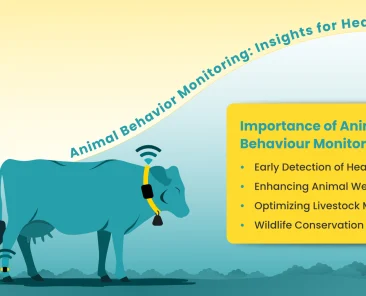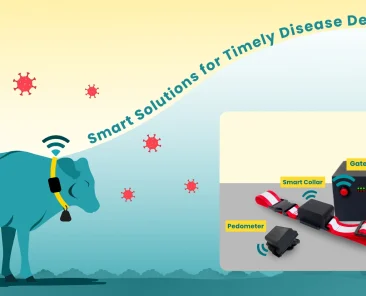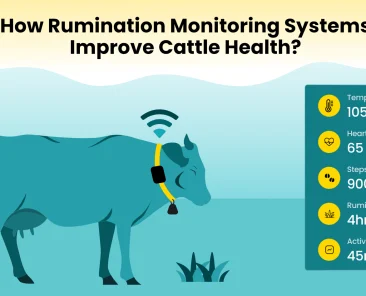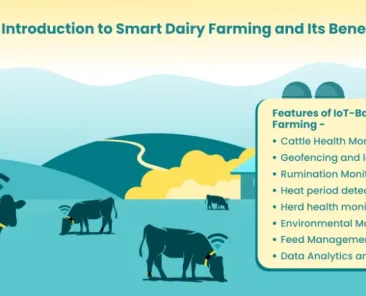Animals can’t tell us when they feel unwell or stressed out, but they show the signs of illness through their behavior, just like humans. That’s what makes animal behaviour monitoring…
- Home
- Cow Health Monitoring
- Fitcows: An Effective Solution for Heat Detection in Cattle
Fitcows: An Effective Solution for Heat Detection in Cattle
- Categories: Cow Health Monitoring
Get in Touch
Related Blogs
Taking care of cattle health is important for any farm’s success. However, diseases like foot-and-mouth, mastitis, and tuberculosis can seriously affect the animals and productivity. Disease detection in cattle is…
The use of smart technology has transformed the management of animal health. Farmers can keep an eye on animal activity in real-time with livestock monitoring, especially through rumination tracking, which…
Dairy farming is an important aspect of agriculture, and “smart dairy farming” might sound like an oxymoron, but it is a reality now. Large dairy farms with more than 100…
Fitcows cattle monitoring system offers effective heat detection in cattle. In every dairy business, the primary objective is to maintain peak milk production for a longer duration. This is achieved through good reproductive management i.e., to make sure cows calve at optimal intervals.
Fitcows livestock monitoring system comes with smart collars and pedometers that aid heat period detection in cattle.
This saves the farmers time they spend to continuously keep a close eye on their cows, which isn’t always an easy task.
So, let’s understand how heat detection in cattle works and how our product is useful in monitoring heat signs.
But first,
Why Monitor Heat Signs in Cows?
So, cows have an estrus cycle, which is a period when a cow is in heat and can bred. This heat period or estrous cycle in cows varies between 18 to 24 days.
Now, during this time only, insemination can be carried out.
Moreover, when it comes to performing artificial insemination on cows, timing is everything. Because the cow must be inseminated at the perfect time for the AI (Artificial Insemination) to result in conception.
Now, with increased conception rates, cows become pregnant at optimal intervals, thus milk production also remains at its peak.
However, the way to detect whether the cow is in a heat period or not is by monitoring their activity and behavior.
The onset of estrous in dairy cows is identified by changes like physiological activities, rumination, and eating behavior.
So if your goal is to ensure that cows conceive as soon as possible then tracking heat signs to detect the exact right time for insemination is the solution.
What’s the Problem With Traditional Heat Detection Methods in Cattle?
Heat detection in cattle is not a new thing, however, when technology wasn’t around, farmers used to follow different ways to detect heat periods in cows.
Among all those traditional methods, the most popular ones are manual heat detection and tail painting.
Manual heat detection means the farmers have to visually observe each cow for visible heat signs.
The biggest flaw in manual heat tracking is the amount of time that is needed to spend on watching for heat signs. Plus, it also requires a lot of manpower still results in missing up to 50% of cows in heat, reducing the reliability of this method.
Another popular traditional method is tail painting. In this method, paint, chalk, or another substance is put on the cow’s tail.
So, when the cow is in heat and other cows mount her, the chalk will rub off leaving the farmers a telltale sign of heat.
However, tail paintings can also be inaccurate and so are unreliable. Because there can be cases when a cow might be in heat but was not mounted or the chalk did not rib off enough to be noticeable.
IoT Technology Taking Over Dairy Farming
Several traditional industries are undergoing tech revolutions and dairy farming is no exception.
The most impactful technology introduced in dairy farming till now is IoT (Internet of Things) because of its ability for remote monitoring and collection of real-time data.
Fitcows offers smart IoT solutions like smart collars and pedometers to track cattle activity, their behavior, along signs of heat.
The major benefit of using IoT IoT-based smart livestock monitoring system is digital monitoring continuity and accuracy.
Because continuous 24/7 monitoring means, a farmer can be alerted at the correct time about insemination regardless of what time of day or night it is.
What Should be Monitored for Heat Detection in Cattles?
While several parameters explain and give signs that a cow is in heat. However, eating pattern (rumination) is important for accurate estrus detection in cattles.
Rumination patterns and the inset of the estrous cycle in dairy cows are strongly linked. Because it has been found that the rumination time in cows decreases by 15-17% on the first day of estrous.
However, it’s important to note that estrous cycle detection is just one part of successful breeding, as AI must be timed accurately to make sure the sperm meets with oocytes and fertilization occurs.
Fitcows Cattle Monitoring Solution
It is a complete livestock monitoring system that comprises of livestock monitoring devices and cattle management software. That’s how it provides comprehensive herd management with automated heat detection.
The Fitcows system detects heat detection in cattle by tracking the activity and behavior patterns of the cow. This is achieved by analyzing the data collected from smart collars and pedometers attached to the cow.
The Fitcows smart cattle monitoring system includes three major components- the hardware devices (collars and pedometers), the gateway, and the software.
For instance, the pedometer counts the steps taken by the cow and sends this data to the heat detection module, where it is analyzed to determine whether the cow is in heat or not.
Other than that the collar also measures additional rest behavior in a cow that includes the duration of lying or standing.
The smart system enables real-time monitoring of the heat period in cows and gives information on detailed reproductive parameters like pregnancy rate, conception rate, heat detection rate, open days, calving intervals, average days in milking, and much more.
Benefits of using Fitcows smart collars with pedometers for heat detection:
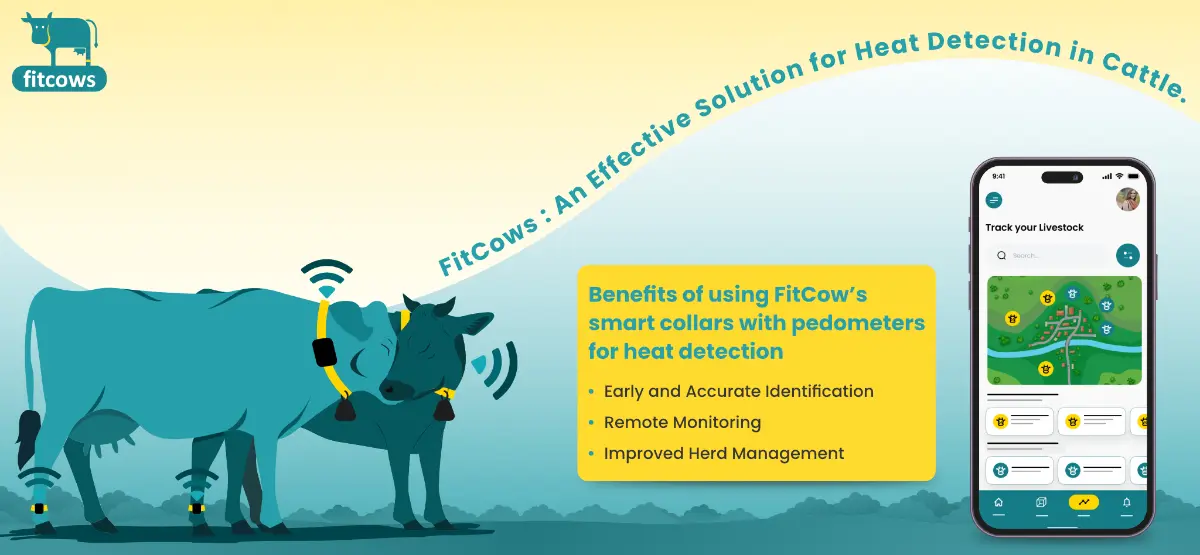
The main benefits that a Fitcows system offers are:
Early and Accurate Identification: Traditional methods of heat detection in cattle can be subjective and time-consuming. Smart collars provide objective data, allowing farmers to pinpoint the optimal insemination window, increasing the chances of a successful pregnancy.
Remote Monitoring: Farmers can track cow activity from their smartphones or computers, eliminating the need for frequent physical checks of the herd.
Improved Herd Management: Heat detection in cattle provides detailed data that can be integrated with herd management software, allowing farmers to optimize breeding programs and calving schedules.
To end up,
Many smart solutions are available in the market for monitoring cow activity, but if your business goal is to achieve growth, then choose a solution that can easily be integrated into your current system.
Fitcows smart solution offers very detailed data that can be leveraged to increase successful AI rates and improve overall herd health.
If you want to save time and effort while also boosting profit, then get in touch with us today and take a demo of our solution to know heat detection in cattle works.
FAQs
What are the signs of heat in cattle?
Some of the signs of the onset of heat period in cattle include restlessness, frequent mounting behavior, vocalization, tail raising, swollen and red vulva, clear mucus discharge, decreased appetite, and frequent urination. And observing these behaviors in real time helps in effective breeding management. Fitcows smart cattle monitoring system offers accurate heat detection in cattle to increase breeding opportunities.
What are the methods of heat detection in cows?
Heat detection methods in cows include visual observation of behavior, using tail paint, activity monitors, heat detection patches, automated sensors, and hormone synchronization. These techniques help accurately identify the optimal breeding time
How does a heat detection system work?
A heat detection system uses sensors to monitor changes in cows’ activity, behavior, and physical indicators, like body temperature and movement patterns, signaling estrus. Data is analyzed to accurately detect heat periods, improving breeding efficiency and productivity.
Get in Touch
Related Blogs
Animals can’t tell us when they feel unwell or stressed out, but they show the signs of illness through their behavior, just like humans. That’s what makes animal behaviour monitoring…
Taking care of cattle health is important for any farm’s success. However, diseases like foot-and-mouth, mastitis, and tuberculosis can seriously affect the animals and productivity. Disease detection in cattle is…
The use of smart technology has transformed the management of animal health. Farmers can keep an eye on animal activity in real-time with livestock monitoring, especially through rumination tracking, which…
Dairy farming is an important aspect of agriculture, and “smart dairy farming” might sound like an oxymoron, but it is a reality now. Large dairy farms with more than 100…
